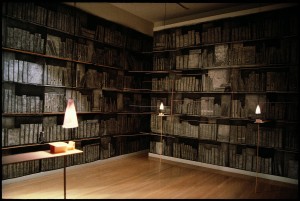French Artist’s Ghostly Library Haunts Gallery
In an age where everything from photos to books is being digitized, libraries stand on the forefront of disappearance. Where will libraries be in the next century? More importantly, which structures will hold the fragile collections of ancient, antique books?
Through his installation, La Bibliothèque (or The Library) at the French Institute Alliance Française (FIAF) gallery in New York, French artist Eric Fonteneau brings to mind these questions with his haunting display of graphite and charcoal rubbings of books from around the world. Rubbing–a Surrealist art technique used in frottage–is the reproduction of a textured surface. Fonteneau places paper over the book surface he wants to reproduce and rubs charcoal and graphite across the page.
“I personally have always been fascinated by libraries,” said FIAF’s Gallery Director Tristan de Terves. “I think we all are. These thousands of books that are like so many open windows of thousands of worlds.”
The rubbings are arranged in a trompe l’oeil covering the walls of the gallery to resemble a real-life library room.
“I love to create art pieces in which me or visitors are included,” Fonteneau commented in an email. “Very often, art is an object. Me, I love when art is also an environment, a world; a world of maps, for example, or of books.”
Born in France, Fonteneau graduated from the University of Haute Bretagne in Rennes with a degree in art studies. Since then, he has worked in France, Burkina Faso, New York, and San Francisco. Fonteneau has always had a passion for drawing and geography, which led to both La Bibliothèque and his earlier project, La Chambre des Cartes (The Map Room).
Similar to the concept of La Bibliothèque, La Chambre des Cartes created a highly atmospheric room that explored geographic and natural forms. Gallery walls were covered with intricate maps drawn with ink, graphite and charcoal. La Bibliothèque uses the same idea, transforming an empty room into something more magical.
“In this installation, I like the simplicity of it,” de Terves said. “I like the fact that he has been traveling for almost 30 years all over the world to collect book bindings.”
As it travels to different galleries, La Bibliothèque changes form to accommodate various spaces. The exhibition has been going for quite a while (the Paule Anglim gallery in San Francisco hosted it in 1999), which means that it has had time to evolve.
“I like the fact that it’s universal, that it’s traveled everywhere,” de Terves said. “I like the simplicity of the process. It’s just rubbing old bindings with charcoal. It’s so simple. I like simple ideas.”
In the beginning, La Bibliothèque was composed of 20 to 30 rubbings of books collected from France. Today, Fonteneau has an ample collection of rubbings from Germany, the U.S., and Japan.
As the exhibition travels, its focus changes, for example, at the San Francisco Art Institute and Art Manoa University in Hawaii, La Bibliothèque became a collection of Japanese World War books. At the FIAF, Fonteneau will present a more cosmopolitan theme.
“Now, my Bibliothèque is a cosmopolitan art piece,” Fonteneau stated. “I love to exhibit in different countries with different conditions: private galleries or public institutions, museums, et cetera.”
However, creating an atmosphere or mood remains central to the exhibition.
“I use the technique of rubbing because it is the simplest one,” Fonteneau stated. “I want to show that simplicity is often very direct and emotional.”
La Bibliothèque can invoke various emotions from its visitors through a ghostly sense of abandonment and hushed mystery — all from simple drawings done on pieces of paper.
“I like the fact that he uses only paper and charcoal to recreate an amazing atmosphere; very magical and mysterious,” de Terves said, “but with simple means and simple ideas.”
Reminiscent of charcoal rubbings of gravestones and epitaphs, the room filled with rubbings of books suggests an impending future without them.
“In [La Bibliothèque], I wanted to make a confrontation between one lonely person and a world of books,” Fonteneau stated.
Perhaps within the next few generations, La Bibliothèque will become a reality, where libraries are long forgotten things of the past.
“A ‘bibliothèque’ is much more than well-stored books on shelves,” Fonteneau commented. “It is a world of souvenirs and the possibility of imagination, personal projections, etc. And that world is always in progress.”
The exhibition is on view from January 19 to February 11 at the French Institute Alliance Française’s gallery. The event is free and open to the public. For more information, visit www.fiaf.org.

